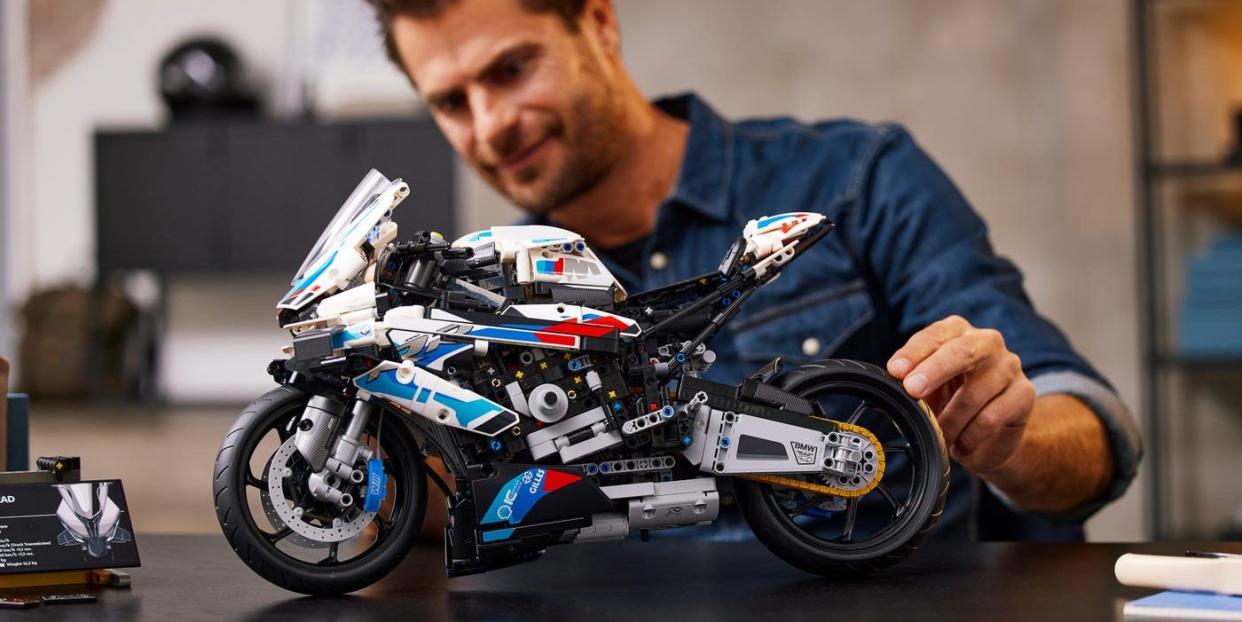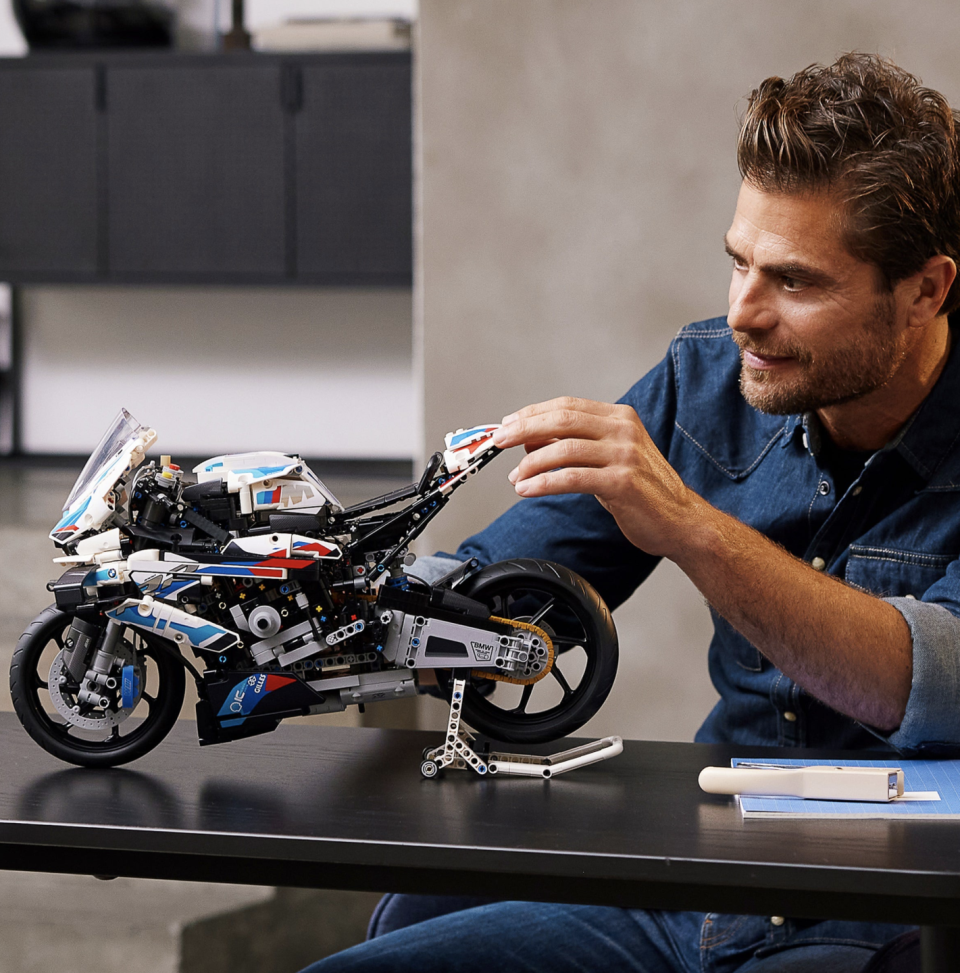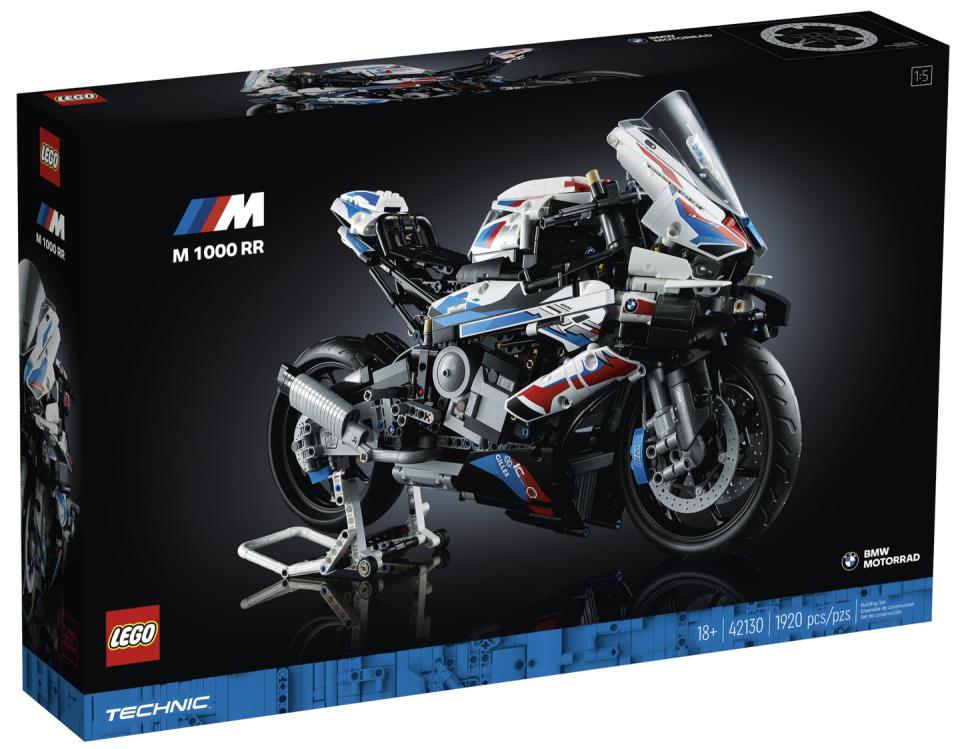Tested: Lego’s New BMW M 1000 RR, Plus Thoughts from the Designer Who Helped the Pieces Click

"Hearst Magazines and Yahoo may earn commission or revenue on some items through the links below."
Right off the bat, this isn't your average, kid-friendly, 30-minute Lego set. This a multi-night, battered-thumbs, test-of-endurance project. And it's designed to be that way. We love it.
Featuring 1920 pieces and two whole sheets of stickers, there's a lot of stuff in the box. However, the end result is fantastic—a 1:5-scale functional model of BMW's first-ever M-developed motorcycle. It's absolutely huge—the largest Lego Technic motorcycle model ever developed—and weighs three pounds. Among the eight new pieces that were developed for this set, the front and rear suspension setup were designed from scratch to support the beast. When you're not testing the new suspension, the bike looks stately on its stand with a nameplate covered in performance stats to easily showcase your victory.
I'm no Lego Master by any means, but I like to think I'm competent—yet this set had me questioning my skills more than once. So to gain even more appreciation for the set, I had a chat with the designer: Samuel Tacchi.
Tested: Three of Lego's Newest Vehicle Sets
How did you become a Lego designer?
Well, it was a huge process, to be honest. I did design school, specialized in transport design, and then started my career at Honda in Italy. I then jumped to the U.K. and worked for Triumph Motorcycles for a little while. And then Lego popped into my LinkedIn, where they announced that they were looking for designers. So I was like okay, I need to try [this] out because I needed something fresh back then in my life. And then here I am. It's gonna be like six years since I've been at Lego Technic ... and my thumbs have been hurting since. But it's really fun working over there. There is a mix of people and variety that I value so much in this job, so I found my happy place.
If someone were to pursue being a Lego designer, what would you suggest is the best route to take?
Well, to be studying design would not be a bad thing because we're all designers here. But also building skills, storytelling, and creativity. It's not always about being a designer, but having good storytelling [qualities], bringing fresh ideas, and teamwork. Being a team player is very important because we share so much during development of a project. [Along with that], being at ease with the Lego bricks and the system in play ... that was something I didn't have when I first started ... and for the first two or three years it was very tough on me because I had to learn everything from scratch. So knowing the Lego bricks is also a plus.

What does an average work day look like for you?
Well, I start my morning by looking at the inspiration website and see what's the news around the design world—I get my brain started this way ... cup of coffee and then a little chat with a colleague, and then I'm off for another day. Sometimes it's challenging, sometimes it's an easy day; I usually [find out] around 10 o'clock if it's gonna be a busy day or an easy day. And then in the afternoon, I go back to my family life and take care of the kids again, and then another day starts.
So it sounds like every day is a bit different.
Yeah, exactly—that's what I like about it. It's non-repetitive for sure, there's always something new and exciting to deal with [during] the day. I think that's a nice aspect of my job that I treasure the most.
What's been the most challenging set you've designed overall?
For sure the BMW, because it's a big model. Any big model, and especially the ones for adults, are very challenging because we are looking into details. Especially the motorcycle, which had never been done before, so I had zero base to start from. Usually when we design a car, we—by experience—know how it works right within the system, but as [the BMW] was in a new scale, I had to start from scratch. So for me, designing this motorcycle is a challenge, and I'm sure for the people building the set [it] is also challenging—which is nice, because that's what we do at Lego Technic. It's part of our DNA. We do challenging builds, so that's something I was looking for.
How do you choose your next design?
It's a talk we have within our team, with marketing and our creative lead—nothing comes from our own head. We also need to have variety within our portfolio; it could be planes, boats, cars, trucks, trains, everything needs to be [spread out] in the right way. We can't have 20 race cars in our portfolio in the same year. So we have a big talk and adjust our whole portfolio.
It's not an easy process—I can't come to the office tomorrow and say I want to do this truck because I like it. I wish it were that simple!
Did you reach out to BMW to design the M 1000 RR or did they reach out to you first?
I don't quite remember ... but one of us had to reach out first because they are a partner [of ours]. Actually, the first project I did with Lego Technic was in collaboration with BMW, which was the hoverbike. So to work with them, I was quite happy, and I don't know if I was a natural selection, but that is up to marketing and my design lead. [So] we knew each other from before, and both Lego and BMW came up with the idea to work on the next generation of motorcycle, and I think both of us were very excited about this project.
How long does designing a set take to complete from beginning to end?
It depends on the complexity, really. Because this motorcycle was very new, we had to create a range of elements to make that possible. So the timeline on this one was a little bit longer than expected, [and the complexity of designing] the new shock absorbers were [a bit contributor]. So I would say roughly a year from start to finish on the development part, and then a few months to work on the building instructions.
Sounds like there are a ton of people involved with the project.
Yes, without them it was not possible for me to move on [with] the project, so hats off to the team.
Definitely goes to show that being a team player is a very nice skill to have.
Exactly, yes, yes.

Do you have a dream motorcycle? Do you have it now?
Well, in Denmark everything is super expensive, so I cannot have any motorcycle I want, and I don't have a huge garage, which would make things [easier]. But since I moved here, I have had two bikes. The first one is a first-generation Ducati Monster, and the one I have now is a Honda CB650. So not a dream bike, but it's not accessible here in Denmark—it's gonna cost too much!
Regardless of price, what's your dream bike then?
I think I would go with the last V2 Streetfighter from Ducati. Special mention to this one because the designer who designed it is a good friend [of mine].
How do you know if the extra pieces after each pack are truly extra, or you forgot something?
After some years of working on Lego models you start recognizing the elements. If, for example, you end up with two extra gears, then you probably have messed it up in the previous steps. When I test builds, I prepare every single element for each step because it's a way for me to focus on ... how we build it. Always rely on the building instructions—they're top notch. If you end up with big elements, you probably have missed something in the instructions.
I wish there was something at the end of each pack in the instructions that said the extra pieces you SHOULD have ... like two chain links, a blue stud, and a 1x2, and so on.
That's a good idea, actually, I had never thought about that.
Ha, glad I can contribute an idea to the Lego people—that's pretty cool! And finally, do you have any suggestions to soothe your thumbs after an intense building session?
Sometimes working at Lego compares to climbing—after a few months your fingers start to get super strong, and I think that's what's happened now. I can dismantle a model without any harm. So my first solution [for dismantling] is to use pliers, to just make it easy on your fingers. That's what I was doing my first year, actually.
I can say that I [can't be a] hand model, I cannot do that anymore, they are totally destroyed. I like the comparison between the Lego builder and a climber.
Well, thank you for your time Sam, it was a pleasure talking with you.
Thank you for the questions. It's always nice to remember part of the project you did at Lego, because now I'm two models ahead of the BMW so it's nice to remember it. Take care.

